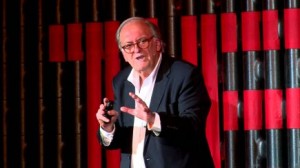Organizations grow in many ways: organically and quietly, organically and exponentially, by acquisitions or mergers etc. In every step of growth there will always be more problems to solve. This will lead to more structures, processes and systems to address them and to cope with the new complexity.
At the beginning of the growth curve, the marginal gains of growth are worth that increased complexity. But left to continue in this way, there will be a threshold beyond which, coping with the complexity starts to counterweigh the benefits gained or to be gained. At some point, the value of complexity may enter into the negative.
It may almost be impossible at that stage to unbundle complexity and simplify the system, due to the nature of the interdependence of all the components that complexity has generated. Then, rewinding is not an option anymore.
Organizations only know one way to cope with this situation, which is to cut headcount, downsize, right size, consolidate, shrink or whatever one wants to call it. But, deleting nodes in the network of interdependent connections does not guarantee a smaller network. Indeed that network may collapse. It is like having a five star hotel and deciding to cut costs by closing half of the bedrooms whilst keeping the heating going, or closing down the kitchen and offering chocolate bars. The problem is having the five star hotel in the first place.
The Organizational Growth-Complexity Paradox that I have described above is my translation of Joseph Tainter’s [1] explanation of how complex societies collapse (1988). Societies – he said – such as the Roman Empire, had a lot of sophistication, and, because of it, they could expand, they created more resources and needed to build the mechanisms to cope with their management. In the case of the Romans, there were plenty of weaker territories around to absorb, at least for a while. But that in itself became the problem: the management of complexity of communications, civil structures, the military, etc. At some point the system (the Empire) collapsed and split in two. The rest is history.
Incidentally, another way organizations cope with diminished returns in a stage of high complexity is the Roman Empire route: M&A.
Tainter went on to say that collapse was actually the best possible outcome for the Empire, and not always bad for people. He quotes archaeological evidence showing that nutrition of individuals was better after the collapse than before.
Clay Shirky (2010 [2]) has also applied this concept to the collapse of complex business models, particularly in the digital world.
Organizational complexity is often seen as inevitable and part of growth itself. Sometimes it goes incredibly fast: recruiting, say, 500, or 1000 new people in a short period of time. We have recruiting machineries and perhaps onboarding ones, but it is not clear how, a few months down the road, we will be dealing with the liabilities of the complexity that this rapid hiring has generated. The same applies to M&A situations where the maths of 1+1= 2 don’t work. 1+1= a Big 1. The ‘Big 1’ is a different beast that cannot be understood or manage as the simple sum of its parts.
Every successful growth contains the seeds of failure. So, how we grow matters. Recognising the liabilities is the first step to gain healthy control of growth. But we need a few vaccinations and safeguards.
________________________________________________________________________________________________
Dr Leandro Herrero is the CEO and Chief Organization Architect of The Chalfont Project [3], an international firm of organizational architects. He is the pioneer of Viral ChangeTM, a people Mobilizing Platform, a methodology that delivers large scale behavioural and cultural change in organizations, which creates lasting capacity for changeability.
Dr Herrero is also an Executive Fellow at the Centre for the Future of Organization, Drucker School of Management and an international speaker, he can be reached at: The Chalfont Project [4].

Dr Leandro Herrero is available for virtual speaking engagements. Find out more [5].
Leandro Herrero is frequently voted ‘Best Speaker’ at conferences worldwide. He also speaks to Boards and Leadership Teams, participates in other internal company conferences as a keynote speaker, and is available to run short seminars and longer workshops.
The topics of Leandro Herrero’s presentations and workshops relate to his work as an organizational architect.
Each organization has specific needs to be addressed. Contact us [4] to discuss your needs and to create the most appropriate virtual session for you.